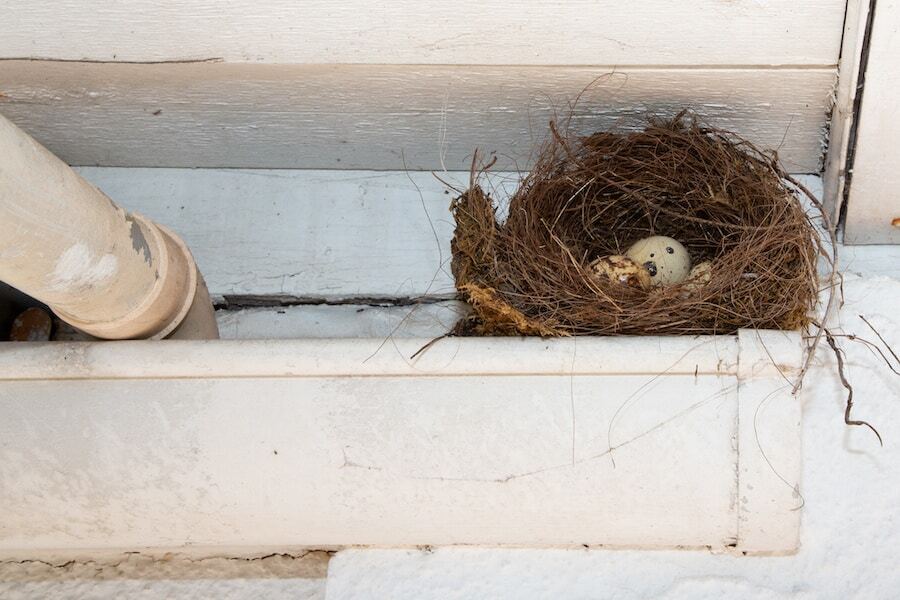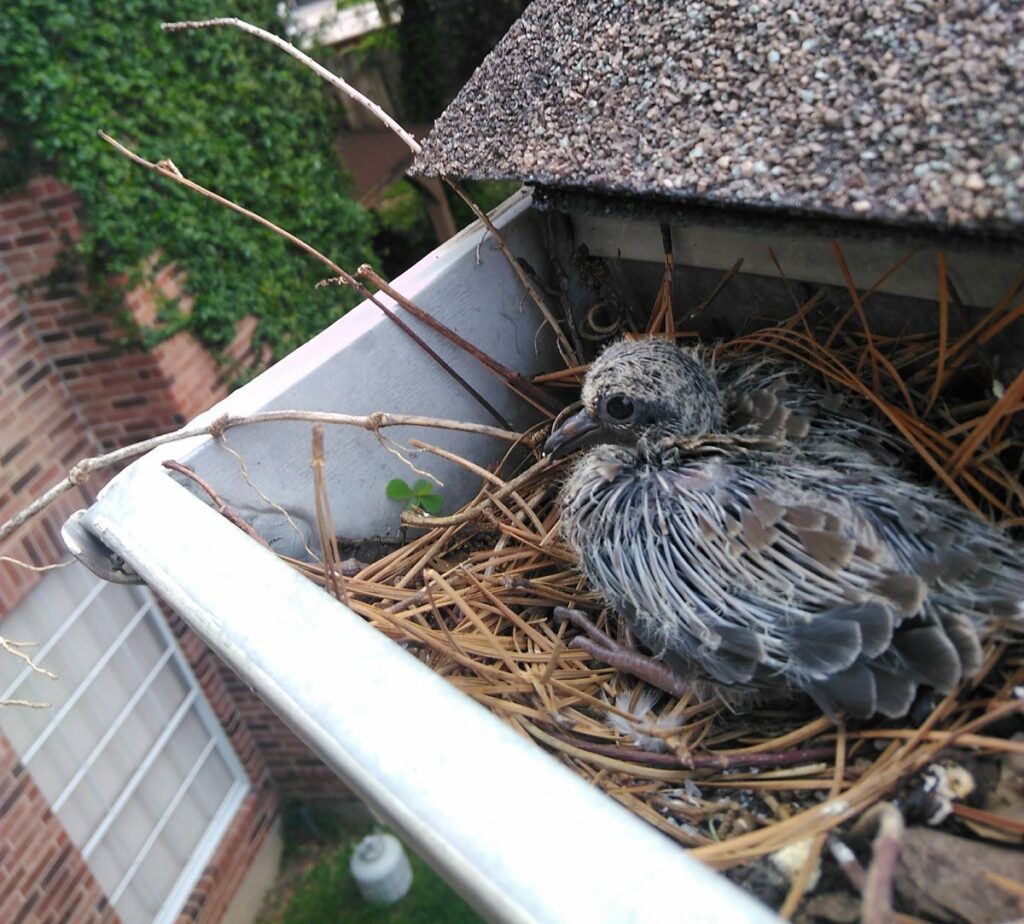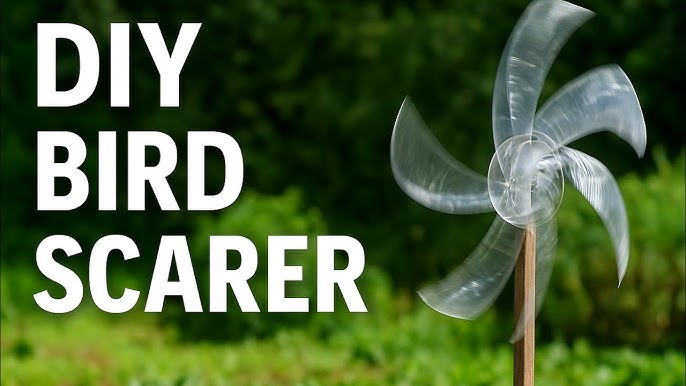Have you ever found a bird trying to build a nest in an inconvenient place around your home? Whether it’s on your porch light, in your gutter, or even on your windowsill, it can be a real challenge.
Not only can nests cause damage, but they can also create a mess and become a safety hazard. You might feel stuck, wondering how to gently stop this persistent builder without harming the bird or breaking any laws. This is a common dilemma faced by many homeowners, and it’s important to handle it with care.
You’ll discover effective ways to prevent birds from nesting in unwanted areas. You’ll learn practical tips that respect both your space and the birds. By the end, you’ll feel confident in managing this situation, ensuring both your home and the birds remain safe and undisturbed. Read on to find the perfect balance between protecting your property and being a considerate neighbor to these feathered friends.
Why Birds Build Nests
Understanding why birds build nests is key to figuring out how to stop them from nesting where you don’t want them. Birds build nests primarily to create a safe and secure place to lay their eggs and raise their young. This natural instinct is driven by survival, making nests a vital part of their life cycle.
Birds look for spots that offer protection from predators and harsh weather. They also need easy access to food sources nearby. Recognizing these needs can help you anticipate where birds might try to build nests around your home or garden.
Common Nesting Spots
Birds can choose a surprising variety of places to build nests. Some of the most common spots include:
- Under eaves or roof overhangs
- Inside vents or chimneys
- In dense shrubs or trees
- On ledges, balconies, or window sills
- In garden sheds or outdoor furniture
If you’ve ever found twigs tucked into your window frame or a small nest under your porch, you’ve witnessed these common choices firsthand. These locations offer shelter and concealment, making them attractive to nesting birds.
Bird Behavior And Nesting
Birds are highly motivated by instinct when it comes to nesting. Once a bird finds a spot it likes, it often returns year after year. This strong attachment means that simply removing a nest might not be enough to stop them.
During the nesting season, birds become more territorial and protective of their chosen spot. You might notice increased activity or noise as they gather materials and build their nests. Understanding this behavior helps you time your efforts to discourage nesting before it starts.
Have you noticed how some birds are more persistent than others? Species like pigeons and sparrows can be especially determined. Observing the type of birds around your property can guide you in selecting the best prevention tactics.

Credit: www.callnorthwest.com
Risks Of Bird Nests In Unwanted Areas
Birds building nests in unwanted areas can bring more than just a few feathers and twigs. While it might seem harmless or even charming at first, these nests can create real problems for your property and health. Understanding these risks can help you decide when and why you need to act quickly.
Damage To Property
Bird nests can cause serious damage to your home or business. Nests built in gutters, vents, or on roofs can block water flow, leading to leaks and water damage. Over time, accumulated debris can rot wood, clog drains, and even cause electrical issues if nests are near wiring.
Think about a neighbor whose attic was invaded by birds. The nesting materials clogged their ventilation, causing mold and costly repairs. Could your property handle the same stress without damage?
Health Concerns
Bird nests often harbor parasites like mites, ticks, and fleas that can spread to humans and pets. Droppings around nests carry bacteria and fungi, posing risks of respiratory diseases such as histoplasmosis. These health hazards aren’t just theoretical; they have affected many homeowners living near active nests.
Have you noticed unexplained allergies or respiratory issues after birds started nesting nearby? This connection might be more than coincidence. Keeping nests away from living spaces reduces exposure to these hidden dangers.
Preventive Measures To Deter Nesting
Stopping birds from building nests on your property often starts with simple, proactive steps. Taking action before a nest is established saves you time and hassle. These preventive measures target what attracts birds and block their access effectively.
Remove Attractants
Birds look for safe, quiet places to build nests, often near food and water. Removing bird feeders, uncovered trash bins, and standing water can make your area less appealing. Clearing away loose twigs or leaves also reduces potential nesting materials right outside your door.
I once struggled with birds nesting near my porch because I left a small water dish for pets outside. Removing it made a noticeable difference in just a week. What small changes can you make around your home to discourage birds from settling in?
Use Physical Barriers
Blocking access to common nesting spots is a reliable way to stop birds. Installing netting, wire mesh, or bird spikes on ledges and eaves keeps birds from landing and building nests. Make sure these barriers cover all potential entry points without harming the birds.
Physical barriers require some effort but deliver lasting results. You might need to check and adjust them regularly, especially during nesting season. Have you noticed which areas birds target most on your property? Focusing barriers there can save a lot of trouble.
Apply Bird Repellents
Bird repellents come in several forms, including gels, sprays, and visual deterrents like reflective tape or fake predators. These create an uncomfortable environment that encourages birds to move elsewhere. Choose repellents that are safe for both birds and people, and apply them according to the instructions.
Using repellents alongside other measures works best. For example, I combined a few visual deterrents with netting around my garden shed, and the nesting attempts stopped quickly. What types of repellents seem most suitable for your outdoor spaces?

Credit: www.crittercontrol.com
Safe And Humane Nest Deterrents
Stopping birds from building nests can be done in ways that are safe for the birds and kind to the environment. Using gentle methods helps keep birds away without causing harm. This approach respects wildlife while protecting your property.
Visual Deterrents
Birds often avoid areas that look unsafe. Shiny objects, such as reflective tape or old CDs, scare them away. Moving items like wind spinners or scare-eye balloons create a sense of danger. These items catch light and move with the wind. Birds see these and think a predator is near. Place visual deterrents near the nesting spots for best results.
Sound Devices
Sounds can keep birds from settling in. Devices that emit bird distress calls or predator noises work well. These sounds make birds feel threatened and uncomfortable. Ultrasonic devices produce high-frequency sounds birds dislike but humans rarely hear. Use these devices carefully to avoid disturbing neighbors or pets. Turn them on during times birds usually build nests.
Non-toxic Chemical Options
Safe sprays can discourage birds from nesting. These sprays have smells or tastes birds avoid. They do not harm birds or other animals. Apply these products on ledges, eaves, and other nesting spots. Reapply after rain to keep the effect strong. Always check product labels to ensure safety for pets and children.
Maintenance Tips To Keep Birds Away
Keeping birds from building nests around your home often requires consistent care and attention. Maintenance plays a key role in discouraging birds from settling in unwanted places. Small, regular actions can make a big difference in making your property less inviting to them.
Regular Cleaning
Birds are attracted to places that offer shelter and leftover food. You can reduce this attraction by cleaning outdoor spaces frequently. Clear away fallen leaves, twigs, and any food scraps that could lure birds in.
Make it a habit to sweep patios, balconies, and window sills. Even bird droppings can invite other birds, so removing these promptly helps keep the area less appealing. Have you noticed how a clean, clutter-free spot rarely becomes a nesting site?
Seal Entry Points
Birds often sneak into small gaps and openings to start building nests. Check your home’s eaves, vents, and rooflines for holes or cracks. Use weather-resistant caulk or mesh to seal these spaces tightly.
This simple step can stop birds from making cozy nests in hidden corners. If you have attics or sheds, make sure doors and windows close properly without gaps. What small openings around your home might be inviting birds right now?
Trim Surrounding Vegetation
Overgrown bushes and trees close to your house provide ideal cover for nesting birds. Keeping plants trimmed back reduces their hiding spots and access points. Regularly prune branches that touch your roof or walls.
Limiting dense vegetation also improves visibility, making birds feel exposed and less likely to settle nearby. Consider how trimming a few branches changed your yard’s look and possibly kept birds away. Could your garden use a little more space and light to discourage nesting?

Credit: www.youtube.com
When To Seek Professional Help
Knowing when to seek professional help is crucial if you want to stop birds from building nests on your property safely and legally. Some situations require expertise beyond DIY efforts, especially when dealing with laws or persistent birds. Ignoring these signs could lead to harm to the birds or legal trouble for you.
Dealing With Protected Species
Many birds are protected by law, which means you can’t remove their nests or disturb them without permission. If you spot species like swallows, eagles, or owls starting to build a nest, it’s time to call a wildlife expert. Professionals know how to handle these situations without breaking any regulations.
Have you checked if the birds nesting on your property are protected? Contacting your local wildlife agency can give you clear guidance. Professionals can help you obtain the necessary permits or suggest safe alternatives that won’t disturb the birds.
Handling Persistent Nesting
What if birds keep coming back despite your efforts? Persistent nesting can be frustrating and sometimes damaging to your property. When your usual deterrents fail, professional pest control or wildlife specialists can assess the situation and apply more effective solutions.
These experts might use humane repellents, install physical barriers, or even relocate the birds safely. They understand bird behavior, so their approach minimizes stress to the animals while protecting your space. Have you tried different methods and still see nests forming? It could be time to bring in a professional.
Frequently Asked Questions
How Can I Prevent Birds From Nesting On My Property?
Use bird deterrents like spikes, netting, or reflective objects. Regularly remove nesting materials and block potential nesting sites early.
What Materials Repel Birds From Building Nests?
Bird spikes, mesh netting, and reflective tape effectively deter birds. These materials make surfaces uncomfortable or uninviting for nest building.
When Is The Best Time To Stop Birds From Nesting?
Prevent nesting before birds start building, usually early spring. Early intervention is key to keeping birds from settling in.
Are There Safe Ways To Remove Bird Nests?
Yes, remove nests after birds have left to avoid harm. Use gloves and dispose of nests properly to maintain hygiene.
Conclusion
Stopping birds from building nests takes patience and simple steps. Remove materials birds use for nesting. Use safe deterrents like bird spikes or netting. Keep your space clean and free from food scraps. Check areas regularly to prevent new nests.
Remember, birds want safe places to stay too. Be kind but firm in your approach. Small actions make a big difference over time. Protect your home while respecting nature’s needs. This balance helps keep birds away gently and effectively.

